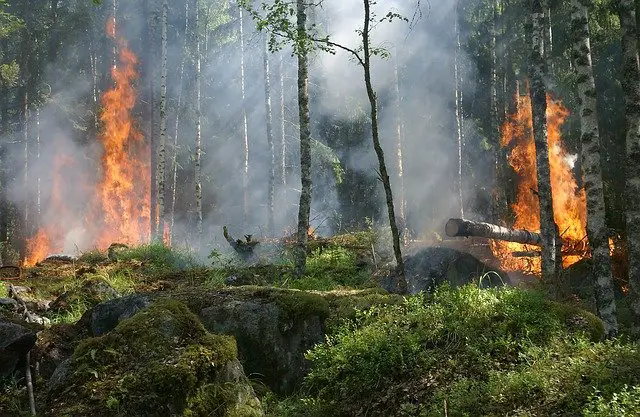Here’s an interesting thought: What if you were to discover that fire may not only help some tree species but might actually aid in the survival of an entire forest and its ability to thrive?
Land managers, ecologists and other qualified professionals have learned over the years about the importance of a so-called fire regime and how it can be important and vital to an ecosystem’s survival.
Controlled fire can remove aging trees and clear the forest floor of debris, allowing smaller trees to grow. Some tree species have seeds that only sprout when the heat of a fire melts the resin protecting it. Other trees have dormant buds that are only exposed after a fire at which point they sprout.
There are also some benefits to certain animal species who can take advantage during the aftermath of a fire.
Let’s look at how a fire can actually help certain trees and thus an entire forest regenerate and grow rather than killing it off. We’ll also take a look at how the animal kingdom is impacted.
Some tree species are fire dependent
Some species such as Eucalyptus, the lodgepole pine and the jack pine are trees that grow cones or fruits that are completely sealed with resin that prevents their seed from spreading. Only a heat that is hot enough to melt the resin – the heat from a fire will do – allows the seeds to break free and spread.
When hundreds or thousands of seeds are released on the ground in this manner, this leads to new trees growing even in the remnants of a large fire.
Other trees such as the shortleaf pine and the California buckeye have dormant buds that remain underground protected from elements but are then exposed and allowed to sprout after a fire.
Fire activates some tree seeds
There are some tree species that require heat from a fire, smoke from a fire or exposure to nutrients on the ground following a fire to sprout properly.
In this instance, the seeds have a strong exterior coating that helps them remain dormant until a fire produces an effect to end the dormancy and allow them to sprout.
Some species of Buckthorn including the Ceanothus, Coffeeberry, and Redberry trees fall into this category and actually sprout after a fire has occurred.
As a result of this, some forest managers use a controlled fire to produce this effect to actually help the forest grow rather than destroy it.
Fires regenerate some trees
While forest fires can devastate entire forests and cause hundreds of millions of dollars of damage to homes and businesses, there are benefits of a controlled fire to some tree species.
Fire kills off large, aged trees that are often more susceptible to insects and infestation. Large trees can often overpower smaller ones by towering over them like a canopy, restricting them, reducing their access to the sun and thus preventing them from growing properly.
Fire can also remove dead vegetation and other debris on the ground which can also limit seed distribution and thus tree growth.
Research from as far back as 1994 showed that fire-adapted plants may be aided during the germination process by smoke, light gaps or the removal of organic matter from a fire to germinate.
from as far back as 1994 showed that fire-adapted plants may be aided during the germination process by smoke, light gaps or the removal of organic matter from a fire to germinate.

Fires distribute vegetation
“Fire is under-appreciated as a global control of vegetation structure…” Source: New Phytologist Foundation .
.
This quote comes from a 2004 study called The global distribution of ecosystems in a world without fire which researched the effects of fire regime on global vegetation patterns.
Fire can kill off insects and infestations, remove dead vegetation and kill off live vegetation resulting in the positive distribution of nutrients to nearby trees that survive the fire.
The report concluded by acknowledging that it was the first known integrated study of its kind on the global extent of fire-dependent ecosystems. It raised many questions regarding how to determine a global fire regime to benefit ecosystems.
Since then many forest managers have begun to use controlled fire as a positive method to grow healthy forests.
Fires can positively impact some animal species
Some animals are able to take advantage of fires as in the aftermath of the damage, it brings out their prey who also try to take advantage of the situation.
According to the Canadian Wildlife Federation , some animal species such as the black-backed woodpecker can increase its population by up to 50x following a fire by feeding on bark beetles that devour the burned wood.
, some animal species such as the black-backed woodpecker can increase its population by up to 50x following a fire by feeding on bark beetles that devour the burned wood.
Canada Lynx consume snowshoe hares which have fewer places to hide following a fire.
They also report that moose and elk benefit from new vegetation that grows in an area that has experienced a forest fire.
Summary
While out of control forest fires can be incredibly damaging to humans, animals, vegetation and inanimate objects like houses, controlled fire can actually benefit certain tree species. Whereas some tree species require fire to help them sprout leading to regrowth, fire can also kill off larger trees that can limit the growth of smaller trees that replace them.
Some trees have also developed protective features such as thicker bark to protect against low level fires which also helps them survive a forest fire that might be deadly to other lesser species.
Some animal species can also benefit with better access to their prey although clearly the prey don’t benefit in the same regard.

